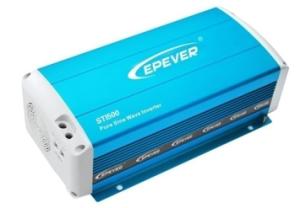On Grid Solar Inverter GW5048D-ES / GW3648D-ES
- Loading Port:
- Shanghai
- Payment Terms:
- TT or LC
- Min Order Qty:
- 10 unit
- Supply Capability:
- 100 unit/month
OKorder Service Pledge
OKorder Financial Service
You Might Also Like
Decription:
GoodWe ES series bidirectional energy-storage inverter is applicable for both on-grid and off-grid PV systems and can control the flow of energy hybrid with its working situation able to be switched automatically or manually. During the day time, the PV plant generates electricity which can be provided to the loads, fed into the grids or charged the battery. The power stored can be released when the loads require it during the night. Additionally, power grid can also charge the storage devices via the inverter.
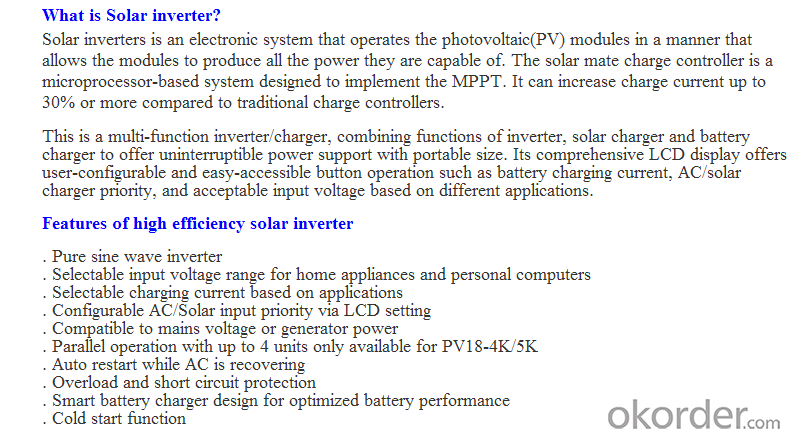
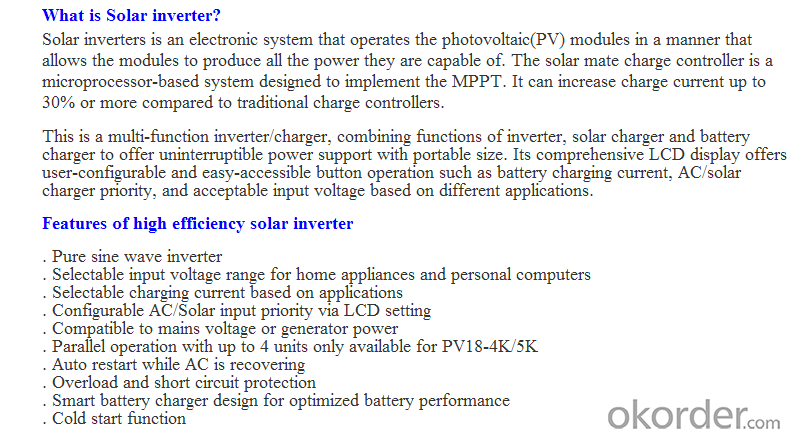
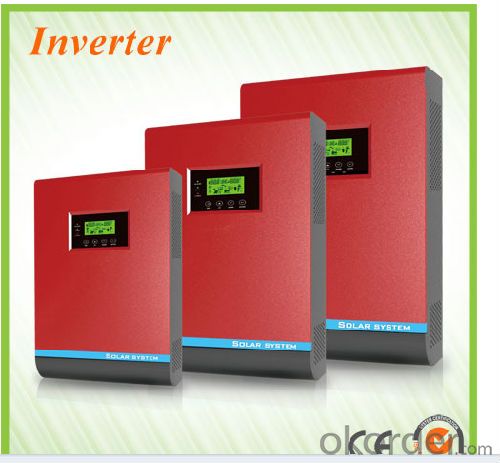
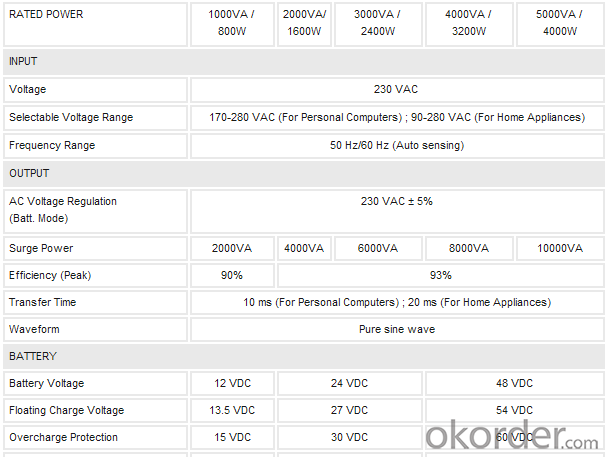
FAQ:What about your warranty?
Our warranty is 1 year
- Q:How does a solar inverter handle varying solar irradiance levels?
- A solar inverter handles varying solar irradiance levels by continuously monitoring the incoming solar energy and adjusting its output accordingly. When the solar irradiance level is high, the inverter increases its output voltage to maximize power conversion. Conversely, when the solar irradiance level drops, the inverter reduces its output voltage to maintain a steady and efficient power conversion. This adaptive response ensures that the solar inverter efficiently converts the available solar energy into usable electricity regardless of the varying solar irradiance levels.
- Q:How do you calculate the total power capacity for a solar inverter?
- To calculate the total power capacity for a solar inverter, you need to consider the maximum power output of the solar panels connected to it. The total power capacity of the inverter should be equal to or greater than the total maximum power output of all the solar panels combined. This ensures that the inverter can handle the maximum power generated by the solar panels and efficiently convert it into usable electricity.
- Q:Grid-connected inverter is generally divided into photovoltaic power generation grid-connected inverter, wind power grid-connected inverter, power equipment and grid-connected inverter and other power generation equipment power generation inverter.
- Grid-connected inverter is generally used with large-scale photovoltaic power plant system, a lot of parallel PV string is connected to the same set of inverter DC input, the general power of the use of three-phase IGBT power module, power
- Q:Can a solar inverter be installed in a multi-storey building?
- Installing a solar inverter in a multi-storey building is indeed possible. The process of installation in such a building is similar to that in any other structure. Usually, the solar panels are placed on the rooftop or another open area that allows for maximum sunlight exposure. The solar inverter then converts the DC power generated by the panels into AC power. In a multi-storey building, the solar inverter can be positioned either on the rooftop or in a dedicated room or space on one of the floors. Factors like accessibility, ventilation, and proximity to the solar panels should be considered when deciding where to install it. Compliance with local building codes and regulations is crucial to ensure the inverter is placed in a safe and secure location. Furthermore, proper installation of the wiring and cabling necessary for connecting the solar panels to the inverter is essential. The vertical distance between the panels and the inverter should be taken into account. Additionally, precautions must be taken to prevent any harm or electrical risks during the installation process. By carefully planning and using appropriate installation techniques, a solar inverter can be readily installed in a multi-storey building. This installation will enable the utilization of solar energy and reduce electricity costs for the building's residents or occupants.
- Q:How does a solar inverter handle grid islanding conditions?
- A solar inverter handles grid islanding conditions by continuously monitoring the grid voltage and frequency. In the event of a grid outage or disturbance, the solar inverter detects the change and disconnects from the grid to ensure the safety of utility workers. It then enters islanding mode, wherein it generates electricity from the solar panels and supplies it to the local loads. This prevents backfeeding and maintains a stable power supply within the isolated system.
- Q:How does a solar inverter monitor and optimize energy production?
- A solar inverter monitors and optimizes energy production by tracking the amount of solar energy being generated by the solar panels. It continuously adjusts the voltage and current to ensure the maximum power is being extracted from the panels. Additionally, it monitors the grid conditions and adjusts the output accordingly to ensure compatibility and stability. Through advanced algorithms and real-time data analysis, a solar inverter maximizes energy production by continuously adapting to the changing environmental and grid conditions.
- Q:Can a solar inverter be used with a solar-powered educational system?
- Yes, a solar inverter can be used with a solar-powered educational system. A solar inverter is an essential component that converts the direct current (DC) produced by solar panels into alternating current (AC) that can be used to power electrical devices, including educational systems. By using a solar inverter, the solar energy generated by the system can be efficiently utilized for educational purposes.
- Q:Can a solar inverter be used with a solar-powered water pumping system?
- Yes, a solar inverter can be used with a solar-powered water pumping system.
- Q:Can a solar inverter be used in a solar-powered desalination system?
- Yes, a solar inverter can be used in a solar-powered desalination system. A solar inverter is responsible for converting the DC (direct current) output from solar panels into AC (alternating current) electricity that can be used to power various devices. In a solar-powered desalination system, the solar inverter would play a crucial role in converting the DC power generated by the solar panels into the AC power necessary to operate the desalination equipment, thereby enabling the system to function efficiently.
- Q:Can a solar inverter be used with different types of communication interfaces?
- Yes, a solar inverter can be used with different types of communication interfaces. Many modern solar inverters are designed to be compatible with various communication protocols such as Wi-Fi, Ethernet, RS485, and Zigbee. This allows for easy integration and monitoring of the inverter with different types of communication systems and devices.
1. Manufacturer Overview |
|
|---|---|
| Location | |
| Year Established | |
| Annual Output Value | |
| Main Markets | |
| Company Certifications | |
2. Manufacturer Certificates |
|
|---|---|
| a) Certification Name | |
| Range | |
| Reference | |
| Validity Period | |
3. Manufacturer Capability |
|
|---|---|
| a)Trade Capacity | |
| Nearest Port | |
| Export Percentage | |
| No.of Employees in Trade Department | |
| Language Spoken: | |
| b)Factory Information | |
| Factory Size: | |
| No. of Production Lines | |
| Contract Manufacturing | |
| Product Price Range | |
Send your message to us
On Grid Solar Inverter GW5048D-ES / GW3648D-ES
- Loading Port:
- Shanghai
- Payment Terms:
- TT or LC
- Min Order Qty:
- 10 unit
- Supply Capability:
- 100 unit/month
OKorder Service Pledge
OKorder Financial Service
Similar products
New products
Hot products
Hot Searches
Related keywords
